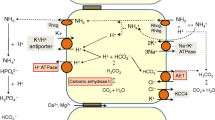Abstract
The effects of enteral administration of various bile salts on bile output were investigated in the rat. After intraduodenal administration, all bile salts significantly increased bile flow and total bile output. Dehydrocholate had the greatest effect on bile flow. Cholate was next in degree of effectiveness followed by taurocholate, deoxycholate, and taurodeoxycholate. Bile output was significantly lower after ileal or gastric intubation of sodium dehydrocholate or taurocholate than after duodenal administration of these compounds. Conjugation of the bile salts tended to depress the overall effect on bile flow. These effects are discussed in terms of possible differences in the absorption of conjugated and unconjugated bile salts. Comparison of the effects of sodium dehydrocholate and taurocholate after intraduodenal and intravenous or intraperitoneal administration suggests that absorption rate or efficiency of absorption markedly influences the intensity of apparent choleretic activity. A relationship was observed between the structure of the bile salt and bile flow stimulation: the triketo form was more effective than the trihydroxy form and that, in turn, was more effective than the dihydroxy form. This is difficult to explain in terms of differences in absorbability but is consistent with a choleresis mechanism involving osmotic pressure effects. At a dose of 100 µmoles, in the rat, dehydrocholate does not function simply as a hydrocholeretic agent. Nevertheless, on the basis of the relative amount (percent) of solids in stimulated bile, there are clear differences in the nature of the choleretic activity of dehydrocholate and cholate.
Similar content being viewed by others
References
Harvey, S. C. “Gastric Antacids and Digestants.” InThe Pharmacological Basis of Therapeutics. Goodman, L. S., and Gilman, A., Eds. Macmillan, New York, 1965, p. 990.
Sperber, I. Secretion of organic anions in the formation of urine and bile.Pharmacol Rev 11:109, 1959.
Brauer, R. W. Mechanisms of bile secretion.J Amer Med Ass 169:1462, 1959.
Haslewood, G. A. D. The biological significance of chemical differences in bile salts.Biol Rev 39:537, 1964.
Smith, R. L. The biliary excretion and enterohepatic circulation of drugs and other organic compounds.Progr Drug Res 9:299, 1966.
Lath, G. H. Transport aspects of bile secretion.Proc Roy Soc Med 60:335, 1967.
Stowe, C. M., andPlaa, G. Extrarenal excretion of drugs and chemicals.Ann Rev Pharmacol 8:337, 1968.
Vanlerenberghe, J. “The Effects of Hypothermia on Biliary Function.” InThe Biliary System—A Symposium of the NATO Advanced Study Institute. Taylor, W., Ed. Blackwell, Oxford, 1965, pp. 263–276.
Roberts, R. J., Klaassen, C. D., andPlaa, G. L. Maximum biliary excretion of bilirubin sulfobromophthalein during anesthesia-induced alteration of rectal temperature.Proc Soc Exp Biol Med 125:313, 1967.
Scratcherd, T. “Electrolyte composition and control of biliary secretion in the cat and rabbit.” InThe Biliary System—A Symposium of the NATO Advanced Study Institute. Taylor, D., Ed. Blackwell, Oxford, 1965, pp. 515–529.
Joseph, D., Sr., Coker, S. T., andEisenbrandt, L. L. Effect of hydration on hydrocholeresis in rats.J Pharm Sci 49:101, 1960.
Dietschy, J. M. Mechanisms for the intestinal absorption of bile acids.J Lipid Res 9:297, 1968.
Sjovall, J., andAkesson, I. Intestinal absorption of taurocholic acid in the rat.Acta Physiol Scand 34:273, 1955.
Faust, R. G., andShih-Min Liu Wu. Observations on the active transport of bile salts by rat and hamster ileumin vitro.Biochim Biophys Acta 120:299, 1966.
Pope, J. L., Parkinson, T. M., andOlson, J. A. Action of bile salts on the metabolism and transport of water-soluble nutrients by perfused rat jejunumin vitro.Biochim Biophys Acta 130:218, 1966.
Dietschy, J. M. Effects of bile salts on intermediate metabolism of the intestinal mucosa.Fed Proc 26:1589, 1967.
Dietschy, J. M., Salomon, H. S., andSiperstein, M. D. Bile acid metabolism. I. Studies on the mechanism of intestinal transport.J Clin Invest 45:832, 1966
Schanker, L. S., Tocco, D. J., Brodie, B. B., andHogben, C. A. M. Absorption of drugs from the small intestine.J Pharmacol Exp Ther 123:81, 1958.
O'Maille, E. R. L., Richards, T. G., andShort, A. H. Acute taurine depletion and maximal rates of hepatic conjugation and secretion of cholic acid in the dog.J Physiol (London)180:67, 1965.
Berman, A. L., Snapp, E., Ivy, A. C., Atkinson, A. J., andHough, V. S. The effect of various bile acids on the volume and certain constituents of bile.Amer J Dig Dis 8:333, 1940.
Hislop, I. G., Hofmann, A. F., andSchoenfield, L. J. Determinants of the rate and site of bile acid absorption in man.J Clin Invest 46:1070, 1967.
Sperber, I. “Biliary Secretion of Organic Anions and its Influence on the Bile Flow.” InThe Biliary System—A Symposium of the NATO Advanced Study Institute. Taylor, W., Ed. Blackwell, Oxford, 1965, pp. 457–467.
Regan, J. F., andHorrall, O. H. The physiologic action of dehydrocholic acid.Amer J Physiol 101:268, 1932.
Reinhold, J. G., andWilson, D. W. The acid-base composition of hepatic bile.Amer J Physiol 107:400, 1934.
Brauer, R. W., andPessotti, R. L. The effect of choleretic and of hydrocholeretic agents on bile flow and bile solids in the isolated perfused liver.Science 115:142, 1952.
Turba, C., andPiccinini, F. Flusso billiare E composizione della bile nel ratto normale E trattato con diedrocolato sodico.Boll Soc Ital Biol Sper 36:262, 1960.
Author information
Authors and Affiliations
Additional information
Supported in part by National Institutes of Health Training Grant Fellowship GM 555-06, and by Grant AM-11498 from the National Institute of Arthritis and Metabolic Diseases, US Public Health Service.
Rights and permissions
About this article
Cite this article
Nightingale, C.H., Gibaldi, M. Bile flow in the rat after enteral administration of bile salts. Digest Dis Sci 14, 545–556 (1969). https://doi.org/10.1007/BF02232929
Issue Date:
DOI: https://doi.org/10.1007/BF02232929




